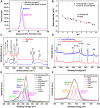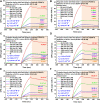Clinical Application for Screening Down's Syndrome by Using Carboxylated Graphene Oxide-Based Surface Plasmon Resonance Aptasensors
- PMID: 33144830
- PMCID: PMC7594198
- DOI: 10.2147/IJN.S270938
Clinical Application for Screening Down's Syndrome by Using Carboxylated Graphene Oxide-Based Surface Plasmon Resonance Aptasensors
Abstract
Background: Advanced medical detection technology requires high sensitivity and accuracy to increase the disease detection rate. We showed that carboxyl-functionalized graphene oxide (carboxyl-GO) biosensing materials are capable of accurate detection.
Methods: We developed a carboxylated GO-based surface plasmon resonance (SPR) aptasensor suitable for screening Down's syndrome in clinical serum. This biosensing material could rapidly and accurately detect hCG protein with a low concentration to identify fetal Down's syndrome. The developed carboxyl-GO-based SPR aptasensor showed excellent sensitivity and limit of detection without the use of antibodies and without any specific preference.
Results: hCG protein detection limits of 1 pM in buffer samples and 1.9 pM in clinical serum samples were achieved. The results showed that the carboxyl-GO-based chip could detect hCG well below the normal physiological level of serum protein (5.0 mIU/mL). High affinity, sensitivity, and better detection limit were obtained in the range of 1.9 pM to 135 pM. The results showed a 5k-fold dilution factor, and that an SPR angle shift of more than 20 millidegrees (mo) was associated with a significant risk of fetal Down's syndrome compared to normal pregnant women. The results clearly showed that the detection of hCG protein in serum samples from pregnant women at 12-19 weeks could be used to screen Down's syndrome with high selectivity and sensitivity.
Conclusion: Our findings suggest the potential application of carboxyl-GO film in proof-of-concept studies for serum assays as a new type of SPR material. In addition, peptide and carboxyl-GO films may be conducive to the development of future point of care testing and rapid diagnostic devices for other diseases such as cancer.
Keywords: DS; Down’s syndrome; GO-COOH; SPR; aptasensor; carboxyl-functionalized graphene oxide; hCG; human chorionic gonadotropin; peptides; surface plasmon resonance.
© 2020 Chiu et al.
Conflict of interest statement
The author reports no conflicts of interest in this work. Conflict of Interest Statement: The authors declare that the research was conducted in the absence of any commercial or financial relationships that could be construed as a potential conflict of interest.
Figures








Similar articles
-
Immunoassay-Amplified Responses Using a Functionalized MoS2-Based SPR Biosensor to Detect PAPP-A2 in Maternal Serum Samples to Screen for Fetal Down's Syndrome.Int J Nanomedicine. 2021 Apr 9;16:2715-2733. doi: 10.2147/IJN.S296406. eCollection 2021. Int J Nanomedicine. 2021. PMID: 33859474 Free PMC article.
-
High-affinity carboxyl-graphene oxide-based SPR aptasensor for the detection of hCG protein in clinical serum samples.Int J Nanomedicine. 2019 Jul 3;14:4833-4847. doi: 10.2147/IJN.S208292. eCollection 2019. Int J Nanomedicine. 2019. PMID: 31308661 Free PMC article.
-
Ultra-high sensitivity of the non-immunological affinity of graphene oxide-peptide-based surface plasmon resonance biosensors to detect human chorionic gonadotropin.Biosens Bioelectron. 2017 Aug 15;94:351-357. doi: 10.1016/j.bios.2017.03.008. Epub 2017 Mar 7. Biosens Bioelectron. 2017. PMID: 28319902
-
Antenatal screening for Down's syndrome.J Med Screen. 1997;4(4):181-246. doi: 10.1177/096914139700400402. J Med Screen. 1997. PMID: 9494915 Review.
-
Screening for Down's syndrome. The role of intact hCG and free subunit measurement.Scand J Clin Lab Invest Suppl. 1993;216:79-96. Scand J Clin Lab Invest Suppl. 1993. PMID: 7690984 Review.
Cited by
-
Determination of the Highly Sensitive Carboxyl-Graphene Oxide-Based Planar Optical Waveguide Localized Surface Plasmon Resonance Biosensor.Nanomaterials (Basel). 2022 Jun 22;12(13):2146. doi: 10.3390/nano12132146. Nanomaterials (Basel). 2022. PMID: 35807986 Free PMC article.
-
Immunoassay-Amplified Responses Using a Functionalized MoS2-Based SPR Biosensor to Detect PAPP-A2 in Maternal Serum Samples to Screen for Fetal Down's Syndrome.Int J Nanomedicine. 2021 Apr 9;16:2715-2733. doi: 10.2147/IJN.S296406. eCollection 2021. Int J Nanomedicine. 2021. PMID: 33859474 Free PMC article.
-
Clinical Application of a Graphene Oxide-Based Surface Plasmon Resonance Biosensor to Measure First-Trimester Serum Pregnancy-Associated Plasma Protein-A/A2 Ratio to Predict Preeclampsia.Int J Nanomedicine. 2023 Dec 7;18:7469-7481. doi: 10.2147/IJN.S438426. eCollection 2023. Int J Nanomedicine. 2023. PMID: 38090367 Free PMC article.
References
MeSH terms
Substances
LinkOut - more resources
Full Text Sources
Medical

